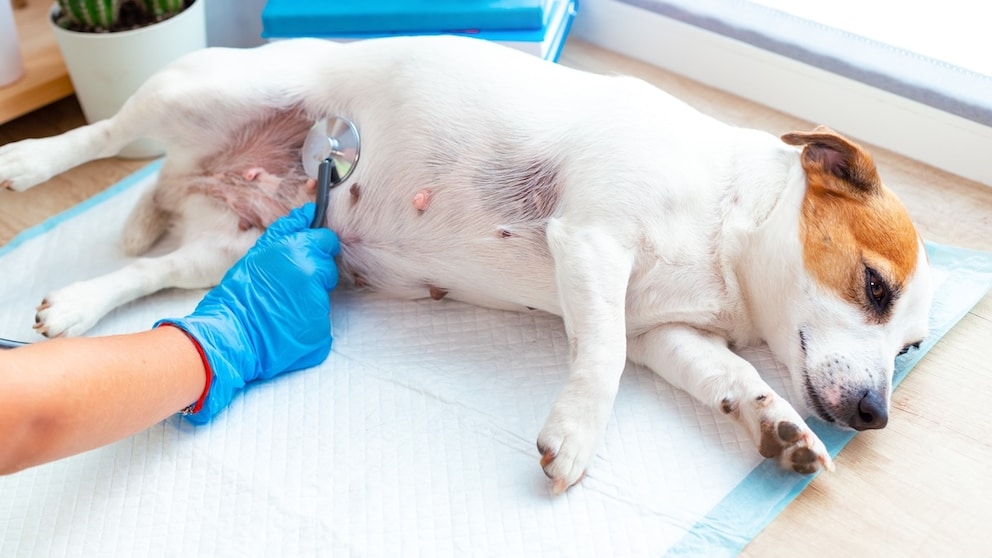May 1, 2025, 8:56 am | Read time: 4 minutes
As a dog owner, if you notice a lump on your female dog’s mammary gland, caution is advised. It could be a mammary tumor, which can be either benign or malignant. Early detection and treatment are, therefore, important.
A mammary tumor is a growth in the mammary glands of dogs. Since it is a mammary tumor, it primarily affects female dogs. Mammary tumors are among the most common types of cancer in older female dogs and can be either benign or malignant. About 50 percent of mammary tumors in dogs are malignant and can metastasize to the lungs, lymph nodes, or other organs. Therefore, early detection and treatment by a veterinarian are particularly important.
Overview
Causes and Risk Factors of Mammary Tumors
In principle, dogs of any age can develop mammary tumors. However, the development of these tumors in dogs is closely linked to hormonal influences. The extent to which spaying reduces the risk of benign or malignant mammary tumors depends on the timing of the procedure. If female dogs are spayed before their first heat, the risk is only about 0.5 percent. Spaying after the first heat increases the risk to 8 percent. After the second heat, the risk rises to 26 percent. Spaying at the age of 2.5 years or older no longer reduces the tumor risk.
Those who choose not to spay their female dogs and suppress heat with hormone preparations should carefully consider this, as they can promote the development of mammary tumors.
Generally, unspayed female dogs are about two and a half to four times more likely to develop mammary gland tumors than spayed dogs. If a female dog is already affected, subsequent spaying has no impact on the disease or a possible recurrence.
Besides the hormonal component, age and breed also play a role: Mammary tumors mostly occur in dogs between eight and twelve years old, and certain breeds, such as Poodles, Cocker Spaniels, Terriers, and German Shepherds, show increased susceptibility. A connection between tumor formation and obesity and high fat consumption has also been established.1
Symptoms
Early signs of mammary tumors in dogs often appear as palpable lumps or hardening along the mammary line. They can occur singly or multiply and often affect one or more mammary lines simultaneously. In some cases, visible changes in the skin over the tumor, such as redness, swelling, or even ulcers, may occur. Malignant tumors can cause pain, especially if they grow rapidly or become inflamed.
If the tumor has already spread, nonspecific general symptoms such as coughing, fatigue, or weight loss may occur. Since even small lumps can indicate malignant changes, early veterinary examination is strongly advised.
Diagnosis
The diagnosis of a mammary tumor begins with a thorough clinical examination of the dog, during which not only the mammary line but also the surrounding lymph nodes are palpated. To rule out or confirm metastases, chest X-rays and an ultrasound of the abdominal organs are usually performed. In many cases, a sample from the tumor is also taken — either through fine needle aspiration or a tissue biopsy — to microscopically determine the type of tumor.
In addition, blood tests provide important information about the dog’s overall health.
Treatment
The treatment of mammary tumors in dogs depends on the size, extent, and malignant potential of the growth. In most cases, the tumor is surgically removed. Depending on the findings, either only the tumor itself, the affected mammary gland, or a larger part of the mammary line is removed. In severe cases, complete removal of the mammary line may be necessary.
If the tumor is malignant or has already spread to other organs, chemotherapy may also be considered. The goal is to slow the progression of the disease and maintain the dog’s quality of life for as long as possible.
Prognosis
The prognosis depends on various factors, particularly the type and size of the tumor, the stage of the disease, and whether metastases have already formed. Benign tumors generally have a good prognosis if detected early.
Malignant tumors usually have a poorer prognosis. However, timely detection and removal of the tumor can improve the prognosis, especially if metastases have not yet formed.
It is not possible to make a blanket statement regarding the prognosis or life expectancy of the dog. It is important to emphasize that early detection can be crucial, which is why even the smallest change in the mammary line should prompt a visit to the veterinarian.2

Horse Not Shedding Its Winter Coat? It Could Be Due to This Disease

Dogs Can Smell Cancer in Other Dogs

What is the difference between castration and sterilization?
Can Mammary Tumors Be Prevented?
The most effective measure for prevention is early spaying before or after the first heat. A balanced diet is also important, as obesity can promote mammary tumors.
Treatment with hormones should also be carefully considered, as it can promote the occurrence of mammary tumors in dogs. Anyone considering hormone treatment should discuss this with their veterinarian.
Additionally, regular veterinary check-ups help detect changes in the mammary glands early.

